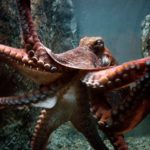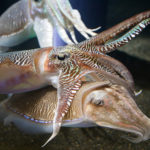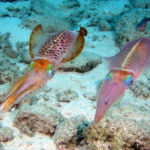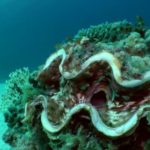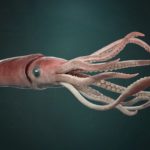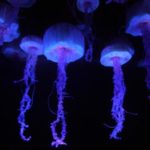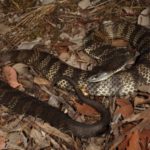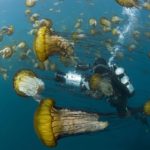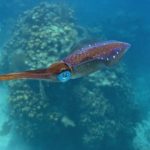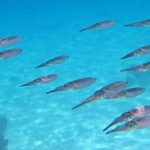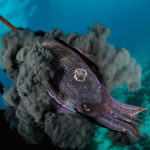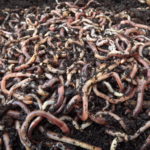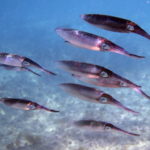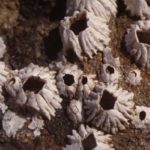Octopus
 The typical and largest representative of octopuses living in our Far Eastern seas is the common octopus, also called the common octopus. Large individuals have a mass of up to 50 kilograms, the length of each tentacle is about 2 meters, hence, with a span of tentacles, it will take 4 meters. The most large octopuses off the coast of Primorye in the Far East can reach 4 meters, from the end of the trunk to the end of elongated tentacles. The span of the tentacles of such an octopus may be about 5 meters, the mass of 70-80 kilograms.
The typical and largest representative of octopuses living in our Far Eastern seas is the common octopus, also called the common octopus. Large individuals have a mass of up to 50 kilograms, the length of each tentacle is about 2 meters, hence, with a span of tentacles, it will take 4 meters. The most large octopuses off the coast of Primorye in the Far East can reach 4 meters, from the end of the trunk to the end of elongated tentacles. The span of the tentacles of such an octopus may be about 5 meters, the mass of 70-80 kilograms.
Each octopus occupies a certain section of the bottom. In storms, octopuses can go to depth, and then invariably return to their territories. Often they settle in any natural shelters – caves, crevices of underwater rocks, niches under stones. Sometimes octopuses dig themselves a refuge or build real castles. Their architectural abilities are unsurpassed. They pile stones, shells and shells of eaten crabs, and on top of the heap make a crater, in which they are arranged.
Often they are closed with a flat stone, like a lid in a saucepan. By the way, octopuses are very fond of dishes, which can sometimes be found at the bottom of the sea, and necessarily settle in it. Taking an outing from his house, the octopus does not throw a stone-lid, but carries it in front of him like a shield. When alarmed, he shields himself with this shield from the side where danger threatens. Retreating, the octopus retreats to his house, closing himself with a stone shield.
Construction of octopuses are usually done at night. Until midnight, they do not make sallies, and then go in search of stones. Eightworldly toilers dragged stones of exorbitant magnitude – five and ten times their own weight.
It is rare to see two octopuses next to each other. Usually, when a larger one appears, the smaller octopus immediately swims away, even if an invasion of its site is committed. In a completely different way, two equally strong animals meet. Here an alien entered the territory of one octopus. The owner of the plot immediately left the shelter, perched on a stone, turned purple and let out two tentacles towards the stranger. The reciprocal gesture was the same. The octopuses intertwined with tentacles and froze. This is similar to the handshake of two wrestlers before a fight. But then they tensed, the tentacles stretched, and the competitions began “tug-of-war”. Each octopus tries to overpower the opponent. After several such efforts, the alien octopus releases its tentacles and hurries away. The winner turns the tentacles and stiffens on the stone, as if on a pedestal.
Benthic octopuses, by nature of feeding, are predators of the trapping type. Lurking in their shelter, they patiently wait for passing fish, crabs, lobsters, lobsters and rush at them, enveloping their long arms. The favorite food of octopuses are Kamchatka crabs. Catching a crab, the octopus carries it, clutching tentacles, like arms, into its shelter. Sometimes one octopus drags several crabs at once. The octopuses also catch large bulls and flounder. Capture of production takes place using suction cups on tentacles.
Their strength is amazing: a sucker with a diameter of 3 centimeters can withstand 2.5-3.5 kilograms. This is very much, especially since the octopus has a hundred suckers. A very ingenious experiment was carried out to determine the strength of the suckers. The octopuses kept in the aquarium were thrown by a crab tied to a dynamometer. The octopus instantly grabbed the crab with his hands and hurried to hide with him in the shelter, but the tie prevented him from doing so. Then the octopus firmly sucked to the crab and began to pull it with force. At the same time he kept the crab with three hands, and the rest sucked to the bottom of the aquarium. Octopuses weighing about 1 kilogram or more could develop a force equal to 18 kilograms.
The taste of food octopuses is recognized not by a tongue, transformed into a grater, but by hands. The entire inner surface of the tentacles and suckers participate in the tasting of food. The sense of taste of the octopuses is unusually subtle, they even taste the enemies. If you drip near the octopus a drop of water taken from the aquarium, where the moray eel lives – the worst enemy of mollusks, the octopus will immediately turn red and start to run.
In the daytime the octopus most often lies motionlessly shapeless lump. To bring the animal out of a sleepy state, scuba divers often tickle or tingle an octopus with a sharp twig. The octopus shudders, rises, its tentacles untwist, and between them the membrane is stretched. The color of the animal acquires a bright red or purple color. It is necessary for the swimmers to retire for some distance, as the octopus turns pale and again occupies the previous pose. If you continue to tease the octopus, he throws out the tentacles and tries to grab the offender. The movements of the tentacles are smooth and easy to avoid. If the octopus manages to grab a man, it is not so easy to escape from it: the octopus has an extraordinary strength. However, the animal quickly realizes that man is an unsuitable prey for him, and he himself releases it.





